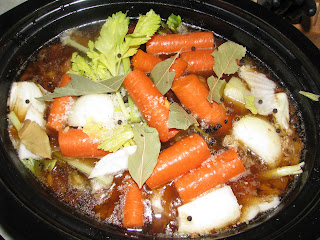Simple Sourdough Bread with a Low Knead Procedure
Makes two large loaves
• 1 Cup Active Sourdough Culture
• 2 Cups Water
• 5 to 6 Cups Flour (divided)
• 1 Tablespoon Salt
Make the sponge:
Night before put one cup active starter into a bowl and add two cups of water and two cups of flour. Stir until reasonably smooth, cover and let set overnight. If the sponge looks active (bubbly) you're ready to go.
Make the dough:
Stir one tablespoon of salt into the sponge. Add three cups of flour to the sponge one cup at a time. Stir to incorporate after each addition. I always stop at this point and judge the dough. With experience, you will know exactly how much additional flour is required. Until you have enough experience, add flour 1/4 cup at a time until you have a soft but not real sticky dough. Use your hands for the last cup or so. Cover the dough and let it rest for 15 minutes or so, so the flour can absorb the water.
Knead the dough:
Knead the dough 15-20 times, let rest for a few minutes and knead again 15-20 times. Repeat once more. Place dough in a lightly oiled bowl, cover with plastic wrap and a towel, and let rise for one to two hours. It does not need to double, but it should definitely increase in volume by at least 50%.
Stretch and fold: Very Important!!! DO NOT PUNCH DOWN! True sourdough does not get punched down like yeast bread. You want it to maintain its airy quality. Dump the dough gently onto a lightly oiled or floured work surface. Gently stretch the dough into a rough rectangle about one third as high as the dough was when dumped on the counter. Fold the dough into thirds like a letter, and then fold the dough in thirds in the other direction. Round the lump of dough and put back in the lightly oiled bowl, cover and let rise until fully doubled. (1-2 hours)
Shape the dough:
Divide the dough into two equal pieces, round, cover, and let rest for a few minutes (5-15). Gently form the rounded dough into loaves to fit your bread pans. Place the dough into buttered bread pans, cover and set aside to rise for another hour or so. It should rise slightly above the pan but if it doesn't don't sweat it. It still tastes great!
Bake the bread:
Bake at 375 degrees for about 40 minutes. Remove from pans and brush with butter.
Notes:
Turn this into a nice whole wheat bread by substituting 1 1⁄2 cups of whole wheat flour for an equal amount of white flour and add one tablespoon of honey and two tablespoons of molasses, or some combination like that.
The thing I love about sourdough is that it doesn't mold like yeast breads. Even after it has gone quite stale it still makes great toast, and I dry in the oven whatever pieces are left and save them to crunch up for breadcrumbs.








